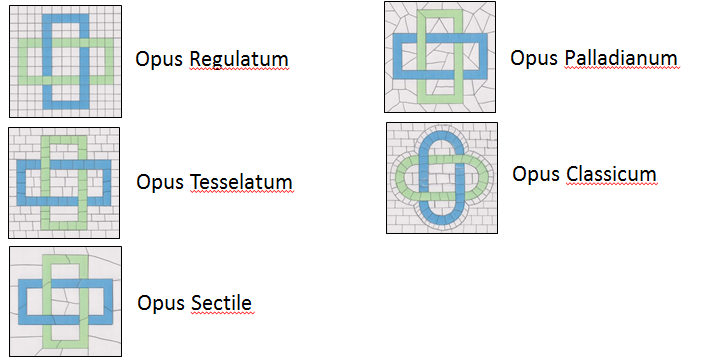 Loading... Please wait...
Loading... Please wait...Knowledge
Newsletter
Terminology
Terminology
There are many terms related to creating mosaics that a beginner should be familiar with. This page serves as an introduction to some of the most common terms.











ANDAMENTO
The flow and direction of the tesserae. There are different styles of andamento, "Opus Regulatum", "Opus Tesselatum" and "Opus Classicum" to name a few.

CARTOON
The full size drawing on which the finished mosaic is based. It is usually worked out on paper in complete detail and in full color. When ready to be transferred to the mosaic surface, it can be done so by using tracing paper (such as Saral), water-soluble ink (if using lime putty) or by tracing the outline with a stylus and making an impression in mosaic surface..
When making copies of ancient mosaics, each tessera is marked and colored on the cartoon so that the mosaic is an exact replica, tesserae by tesserae.
CEMENT/ADHESIVE/BINDER
A substance used to bind particles together providing mechanical strength and solidity, i.e. glue. Produced by loss or absorption of moisture (air dry, for example Weldobond) or by chemical reactions (for example thinset). Temporary, water soluble adhesives, including flour paste and hide glues are also used in the production of mosaics.
CERAMIC MOSAIC TILE
Commerically made or handmade clay tiles in a wide variety of shapes and color. These tiles get their color from a glaze that is applied to the surface. Ceramic tiles are either of the low-fire or high-fire variety. If you will be using these tiles outdoors in freeze/thaw conditions, high-fire is a must. Unfortunately, the high fire process limits the glaze colors available.
CUTTING
The process where smalti and stone is cut into tesserae of various sizes. Since ancient times, the hardie and hammer have been used and have produced the most accurate, satisfying results. In this method, a piece of material is held against the hardie at right angles in the position of a desired fracture and then struck by the opposing hammer with a single, light touch which will create a clear fracture without splintering. Accurate cutting is essential to exploit the qualities of color and reflection in smalti. In ancient times, apprentices would hone their chopping and cutting skills over many years. Today, other tools are also employed such as nippers and chopping machines. It is important to keep the cutting tools sharp.
FILATO
Filato (translated to English: "yarn") is smalti glass that has been pulled into fine threads and is used in the micromosaic process. Visit the micromosaic section of our website for a complete overview of this materials.
GOLD SMALTI
Gold smalti is not uniformly gold. Gold smalti is made of a thin layer of gold sandwiched between two layers of transparent glass. It is very expensive, about 5-6 times the price of colored glass smalti. The traditional method, which is used by MDM, requires pouring a thin layer of glass, applying gold leaf, and then pouring a second layer of glass. Cheaper techniques have been devised, such as placing gold leaf between 2 sheets of plate glass and heating the sandwich, but the adhesion is less secure, resulting in more likelihood of delamination. MDM gold smalti is very resistant to damage - it can be installed on floors, in freeze/thaw conditions and in saltwater pools. For harsher conditions, the double thick, or doppio, variety is recommended.
GROUT
A fluid mixture usually of lime or cement, fine sand, marble dust and water used to fill in the spaces or interstices between the tesserae of a mosaic. See our Knowledge section on Finishing - Grouting for more information on the use of this material. Except for floors, grout is not commonly used in traditional smalti or stone mosaics.
HARDIE
A tool used with mosaic hammer that has a cutting edge like a stone masons chisel fixed into the center of an upturned heavy log.
INTERSTICES/JOINT
The spaces between tesserae, which can vary in width and could be filled with grout. In Byzantine times a wide spacing was considered a part of the overall effect, while the solidity of floor mosaics always depended on a close fitting texture.
LIME PUTTY
A white putty-like mixture made by mixing lime and water. Lime putty is one of the oldest building materials and is used also for fresco painting. In mosaic making, the putty is used as a temporary setting binder in the double reverse method.
MARBLE
A metamorphic rock, mainly comprised of calcium carbonate and crystalline in structure originated from limestone and altered by heat or metamorphic pressure. It has been widely used in decoration and is easily cut and shaped into tesserae. It comes in a wide range of colors depending on the minerals present such as pink, brown, green, black, yellow, brown and white, which is pure calcium carbonate.
MONOCHROME MOSAIC
Roman floor mosaic made with black and white tesserae from 1st century BC to 3rd century AD.
MOSAIC
Mosaic is the art of decorating a surface with designs made up of closely set, small pieces of material such as colored stone, glass or other ceramic. Mosaic pieces are called tesserae. This technique is principally used to decorate walls, floors and vaults. In Byzantine times, a portable mosaic was a small size depicting a single icon or figure such as the saints, and today portable mosaics of any topic still constitute the most common form of mosaic and are of canvas-sized dimension or less.
OPUS
Literally, "the work", i.e. the mosaic itself.
PIZZA
The starting point for smalti. Round discs of glass 1-2 cm thick and 15-30 cm diameter, are made by pressing molten glass paste. After cooling, the discs of glass are cut into strips about 2 cm wide and cut into pieces of smalti, often with a chopping machine.
SMALTI/SMALTO
Translated to English, "smalti" means "enamel". Smalti refers to the opaque colored vitreous glass from which tesserae are obtained for mosaics. Smalti is ordinary glass with metal oxides added as coloring agents and produces an opaque and fleshy effect. Smalti are unique as a mosaic material and in addition to being weather resistant they offer incomparable reflective power and iridescent brilliance. The color variations are practically unlimited and number over 25,000 and vary according to the type of metal oxides used and the melting temperature.
STONE
General term used to describe those natural materials like rock, marble and minerals used to make mosaic tesserae
TESSERAE
Mosaic pieces called tesserae (from the Latin word meaning dice or cubes), applied to a prepared surface with an adhesive such as plaster, cement or mortar.
TRASPARENTI
Yes, the first "n" is missing from the Italian spelling of this word, which simply means "transparent". Trasparenti is made in a process similar to smalti but as the name suggests, it is tranparent glass.
VITREOUS GLASS
Vitrification is a physical transformation of a materials where it becomes a solid, impervious body. The word "vitreous" actually means "glass-like". Vitrification occurs at high temperatures that not all materials can service. Smalti is vitrified glass. So are many other commerically manufactured glass tiles such as Sicis. With vitrification comes a number of benefits, including resistance to the effects of freezing and thawing, stain resistance and easy of and sharpness of cutting.
